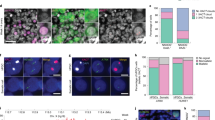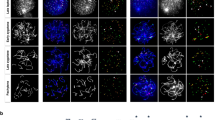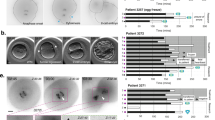Abstract
THERE is considerable evidence that, as a result of some early embryonic event, the genes of one X chromosome in each somatic cell of the human female are not expressed1. Studies of somatic tissues and cultured cells (including fibroblast clones) from human embryos, heterozygous for the common electrophoretic variant of glucose-6-phosphate dehydrogenase (G6PD), indicate that a single active X is present in cells from various tissues, at least by 5 weeks from conception2. On the other hand, the presence of the heteropolymorphic form of the enzyme in oocytes of the heterozygous adult female3 and a 16-week-old foetus4 is compelling evidence that, in meiotic stage germ cells, there are two active X chromosomes; however, the basis for the two active chromosomes in oocytes is not clear. It is conceivable that germ cell progenitors escape inactivation because inactivation occurs when cells destined to become germ cells have already been imprinted. Alternatively, only a single X chromosome may be active in all cells of the early zygote, with the second X activated only in germ cells at some time after their differentiation. The third possibility, that germ cells are subject to inactivation, but that reactivation occurs when meiosis commences, has been suggested by Gartler et al. because they did not observe the heteropolymer in ovaries from a 12-week-old human foetus heterozygous for the G6PD variant5,6. The ovary at that developmental stage contains approximately 23% germ cells, with a preponderance of premeiotic and leptotene germ cells7. But the implication that two functional X chromosomes are required for the onset of mammalian meiosis is not supported by evidence that XO mice produce normal gametes8. Using human foetal material, we have now obtained evidence against the third possibility.
This is a preview of subscription content, access via your institution
Access options
Subscribe to this journal
Receive 51 print issues and online access
$199.00 per year
only $3.90 per issue
Buy this article
- Purchase on Springer Link
- Instant access to full article PDF
Prices may be subject to local taxes which are calculated during checkout
Similar content being viewed by others
References
Lyon, M. F. Biol. Rev. 47, 1–35 (1972).
Migeon, B. R. & Kennedy, J. F. Am. J. hum. Genet. 27, 233–239 (1975).
Gartler, S. M., Liskay, R. M., Campbell, B. K., Sparkes, R. & Gant, N. Cell Differentiation 1, 215–218 (1972).
Gartler, S. M., Liskay, R. M. & Gant, N. Expl Cell Res. 82, 464–466 (1973).
Gartler, S. M., Andina, R. & Gant, N. Expl Cell Res. 91, 454–457 (1975).
Gartler, S. M. & Andina, R. J. Adv. hum. Genet. 7, 99–140 (1976).
Baker, T. G. Proc. R. Soc., Lond. B 158, 417–433 (1963).
Cattanach, B. M. Genet. Res. 3, 487–490 (1962).
Streeter, G. L. Carnegie Inst. Contrib. Embryol. 11, 145–170 (1921).
Blandau, R. J., White, B. J. & Rumby, R. E. Fertil. Steril. 14, 482–489 (1963).
Ohno, S., Klinger, H. P. & Atkins, N. B. Cytogenetics 1, 42–51 (1962).
Ohno, S. in Second int. Conf. Congenital Malformations, 36–40 (National Foundation, New York, 1963).
Author information
Authors and Affiliations
Rights and permissions
About this article
Cite this article
MIGEON, B., JELALIAN, K. Evidence for two active X chromosomes in germ cells of female before meiotic entry. Nature 269, 242–243 (1977). https://doi.org/10.1038/269242a0
Received:
Accepted:
Issue Date:
DOI: https://doi.org/10.1038/269242a0
This article is cited by
-
Sex difference in methylation of single-copy genes in human meiotic germ cells: Implications for X chromosome inactivation, parental imprinting, and origin of CpG mutations
Somatic Cell and Molecular Genetics (1990)
-
Both X chromosomes function before visible X-chromosome inactivation in female mouse embryos
Nature (1978)
Comments
By submitting a comment you agree to abide by our Terms and Community Guidelines. If you find something abusive or that does not comply with our terms or guidelines please flag it as inappropriate.



